 On some days we work in an area away from our usual patch around Saffron Walden and Haverhil. Thursday last week was just such a day, when we were working in and around Royston. Our first job of the day was in Littlington and the second job was in Gilden Morden. Driving between these two villages we saw the impressive memorial in the photo. This is the memorial to the 355th Fighter Group that was stationed at Gilden Morden from July 1943 to July 1945 during World War II. The spinner and propeller on the memorial are from a P-51 Mustang.
On some days we work in an area away from our usual patch around Saffron Walden and Haverhil. Thursday last week was just such a day, when we were working in and around Royston. Our first job of the day was in Littlington and the second job was in Gilden Morden. Driving between these two villages we saw the impressive memorial in the photo. This is the memorial to the 355th Fighter Group that was stationed at Gilden Morden from July 1943 to July 1945 during World War II. The spinner and propeller on the memorial are from a P-51 Mustang.
RAF Bomber Command use
Between 1940 and September 1942, Steeple Morden was a grass satellite dispersal airfield used by No. 11 Operational Training Unit of RAF Bomber Command flying Vickers Wellingtons from RAF Bassingbourn. During this time No. 3 (Coastal) Operational Training Unit RAF (OTU) also used the airfield.
USAAF use
When the airfield was turned over for American use, Steeple Morden was assigned USAAF designation Station 122. Hard-surface runways were laid down, along with concrete hardstands and a permanent T-2 hangar.
3d Photographic Reconnaissance Group
Although not planned for use until 1943 Steeple Morden was first used by the United States Army Air Forces Eighth Air Force 3d Photographic Reconnaissance Group, arriving from RAF Membury on 16 October 1942. The 3d consisted of the 5th, 12th, 13th, 14th, 15th and 23d squadrons and only stayed at the airfield until 10 December, departing for La Senia Algeria as part of Operation Torch. During the stay of the 3d PRG, Lieutenant-Colonel Elliott Roosevelt, son of Franklin D. Roosevelt served as commander and also flew an F-4 “Lightning”.
Between January 1943 and May 1943 the airfield was used by No. 17 OTU which used Bristol Blenheims.
355th Fighter Group
With the departure of the photo-recon squadrons, the 355th Fighter Group, arrived from Philadelphia Municipal Airport on 9 July 1943.[6] The group was under the command of the 65th Fighter Wing of the VIII Fighter Command. Aircraft of the group were identified by white around their cowling and tail.
The group consisted of the following squadrons:
The 355th FG flew its first combat mission, a fighter sweep over Belgium, on 14 September 1943 and afterwards served primarily as escort for Boeing B-17 Flying Fortress/Consolidated B-24 Liberator bombers that attacked industrial areas of Berlin, marshalling yards at Karlsruhe, an airfield at Neuberg, oil refineries at Misburg, synthetic oil plants at Gelsenkirchen, locks at Minden, and other objectives. The group also flew fighter sweeps, area patrols, and bombing missions, striking such targets as air parks, locomotives, bridges, radio stations, and armoured cars.
On 5 April 1944, shortly after converting from Republic P-47 Thunderbolts to North American P-51 Mustangs, the group successfully bombed and strafed German airfields during a snow squall, a mission for which the group was awarded a Distinguished Unit Citation. The group provided fighter cover for Allied forces landing in Normandy on 6 June 1944, and afterwards hit transportation facilities to cut enemy supply lines. Hit fuel dumps, locomotives, and other targets in support of ground forces during the breakthrough at Saint-Lô in July.
The 355th Fighter Group flew its last combat mission on 25 April 1945. On 3 July the group transferred to Gablingen, Germany for duty with United States Air Forces in Europe as part of the army of occupation. Transferred, without personnel and equipment, to Mitchel Field New York on 1 August 1946, and was inactivated on 20 November.
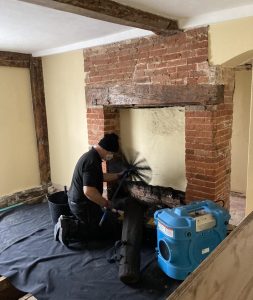
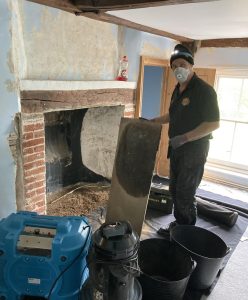



 My name is Paddy McKeown, I am a retired police officer (Detective Sergeant – Metropolitan Police), turned chimney sweep. I have completed training with ‘The Guild of Master Chimney Sweeps’, and Rod Tech UK (Power Sweeping).
My name is Paddy McKeown, I am a retired police officer (Detective Sergeant – Metropolitan Police), turned chimney sweep. I have completed training with ‘The Guild of Master Chimney Sweeps’, and Rod Tech UK (Power Sweeping).
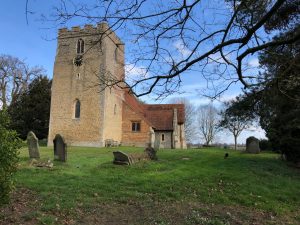
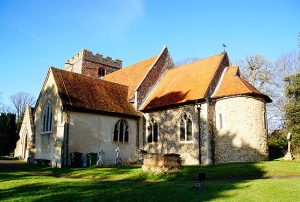 The Early English chancel arch is enormous compared to the tiny one that separates it from the apse. To the right, and hardly separated from the south aisle, is the south transept with the Denny monuments. Sir John Deane’s monument is in the east wall of the north transept. Jon was a minor worthy, serving Essex as Sheriff, Lieutenant and MP for the county before his death. For his place in society as a minor gentleman he was a very wealthy man, having benefited from some hefty inheritances. He clutches what seems to be some sort of staff of office, not a sword which is presumably behind his body. There is no suggestion that he wore his fine armour in any kind of warfare! His wife, Anne Drury, outlived him by eight years and she does not appear on this monument but had one erected for her sole benefit (below). The space above the monument shows his two sons and six daughters. It is suggested that he enjoyed the support of Sir Robert Rich, 2nd Earl of Warwick who held the manor at Braintree. If so, this might explain the appearance of a bear at Sir John’s feet, this being the symbol of Warwick.
The Early English chancel arch is enormous compared to the tiny one that separates it from the apse. To the right, and hardly separated from the south aisle, is the south transept with the Denny monuments. Sir John Deane’s monument is in the east wall of the north transept. Jon was a minor worthy, serving Essex as Sheriff, Lieutenant and MP for the county before his death. For his place in society as a minor gentleman he was a very wealthy man, having benefited from some hefty inheritances. He clutches what seems to be some sort of staff of office, not a sword which is presumably behind his body. There is no suggestion that he wore his fine armour in any kind of warfare! His wife, Anne Drury, outlived him by eight years and she does not appear on this monument but had one erected for her sole benefit (below). The space above the monument shows his two sons and six daughters. It is suggested that he enjoyed the support of Sir Robert Rich, 2nd Earl of Warwick who held the manor at Braintree. If so, this might explain the appearance of a bear at Sir John’s feet, this being the symbol of Warwick.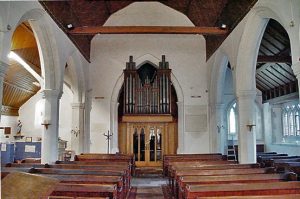
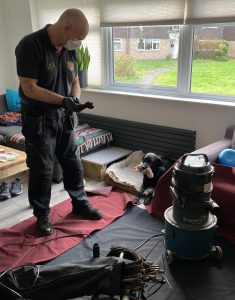 Being dog owners, this is always something that always makes me and Claire smile, a dog who loves our dust sheets! I believe that they think in their heads that we have come just see them, put out some nice bedding for them and make big fuss of them. This is Bell who lives in Meldreth, as can be seen she is a black Labrador and her favourite past time is to show you her toy, which I think was a monkey! There is nothing like a dog to put a smile on your face, loyal, great company and an integral part of any family home.
Being dog owners, this is always something that always makes me and Claire smile, a dog who loves our dust sheets! I believe that they think in their heads that we have come just see them, put out some nice bedding for them and make big fuss of them. This is Bell who lives in Meldreth, as can be seen she is a black Labrador and her favourite past time is to show you her toy, which I think was a monkey! There is nothing like a dog to put a smile on your face, loyal, great company and an integral part of any family home.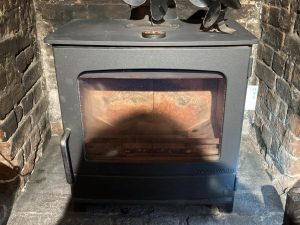

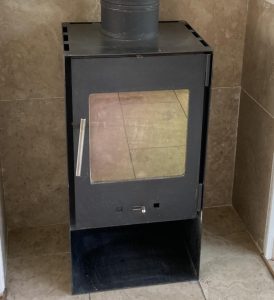 Here is something interesting, and a real rarity, an old, retro Wiking Bazic Wood-Burning stove. I see a lot of the more modern models of the Wiking stoves around the area, like the various models of the Luma, and the Mini, but I have never come across one of these older discontinued models of the Wiking stove company. I came across this example of a Wiking Bazic Wood-Burning stove at an address in Radwinter. Funnily enough, the customer is going to have the Wiking stove taken out and changed to a more contemporary, new stove. Goddard’s stoves in Saffron Walden will be doing the work for him, although he could not remember what make and model the new stove is going to be. He said that he was changing the stove because he felt that he just wanted a different, newer stove, and not because the Wiking stove didn’t perform well. In fact, he said that the Wiking stove was indeed a very efficient stove and that he intended to sell it as second-hand.
Here is something interesting, and a real rarity, an old, retro Wiking Bazic Wood-Burning stove. I see a lot of the more modern models of the Wiking stoves around the area, like the various models of the Luma, and the Mini, but I have never come across one of these older discontinued models of the Wiking stove company. I came across this example of a Wiking Bazic Wood-Burning stove at an address in Radwinter. Funnily enough, the customer is going to have the Wiking stove taken out and changed to a more contemporary, new stove. Goddard’s stoves in Saffron Walden will be doing the work for him, although he could not remember what make and model the new stove is going to be. He said that he was changing the stove because he felt that he just wanted a different, newer stove, and not because the Wiking stove didn’t perform well. In fact, he said that the Wiking stove was indeed a very efficient stove and that he intended to sell it as second-hand. I had to laugh when I saw this thatched dog running off with the sausages on the roof of an address in Great Chesterford, opposite where we were working. I thought that it would make an excellent and funny entry on my weekly chimney sweeping blog. I have seen a very similar thatched dog with sausages on a roof in Balsham, I really must take a photo of that one to compare it with the Great Chesterford example, the next time I’m working in Balsham. I think the Balsham example is on the thatched roof of a coffee shop, that used to be the village butchers’ shop, I will confirm this!
I had to laugh when I saw this thatched dog running off with the sausages on the roof of an address in Great Chesterford, opposite where we were working. I thought that it would make an excellent and funny entry on my weekly chimney sweeping blog. I have seen a very similar thatched dog with sausages on a roof in Balsham, I really must take a photo of that one to compare it with the Great Chesterford example, the next time I’m working in Balsham. I think the Balsham example is on the thatched roof of a coffee shop, that used to be the village butchers’ shop, I will confirm this! On some days we work in an area away from our usual patch around Saffron Walden and Haverhil. Thursday last week was just such a day, when we were working in and around Royston. Our first job of the day was in Littlington and the second job was in Gilden Morden. Driving between these two villages we saw the impressive memorial in the photo. This is the memorial to the 355th Fighter Group that was stationed at Gilden Morden from July 1943 to July 1945 during World War II. The spinner and propeller on the memorial are from a P-51 Mustang.
On some days we work in an area away from our usual patch around Saffron Walden and Haverhil. Thursday last week was just such a day, when we were working in and around Royston. Our first job of the day was in Littlington and the second job was in Gilden Morden. Driving between these two villages we saw the impressive memorial in the photo. This is the memorial to the 355th Fighter Group that was stationed at Gilden Morden from July 1943 to July 1945 during World War II. The spinner and propeller on the memorial are from a P-51 Mustang.


 Yes, as I have said before, doggies just love our dust sheets, whether it is lying on them, sniffing them or playing with them, they just can’t resist our dustsheets. If there is a dog or dogs in the house no sooner have we laid out the sheets they will appear, sniffing them, sitting on them or laying on them. Clearly, we have laid out the sheets just for them and for no other purpose. This Boarder Terrier is a little girl called Indie, she is ever so friendly and loves playing with her little rubber ball. Although we found out that she doesn’t like going outside when it is cold!! Just like the day we visited!!
Yes, as I have said before, doggies just love our dust sheets, whether it is lying on them, sniffing them or playing with them, they just can’t resist our dustsheets. If there is a dog or dogs in the house no sooner have we laid out the sheets they will appear, sniffing them, sitting on them or laying on them. Clearly, we have laid out the sheets just for them and for no other purpose. This Boarder Terrier is a little girl called Indie, she is ever so friendly and loves playing with her little rubber ball. Although we found out that she doesn’t like going outside when it is cold!! Just like the day we visited!!


